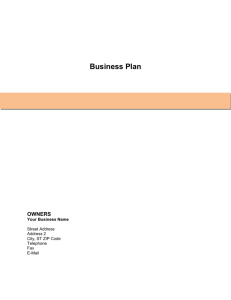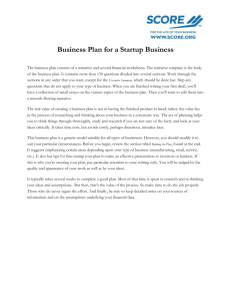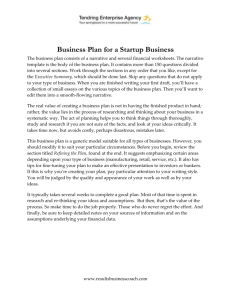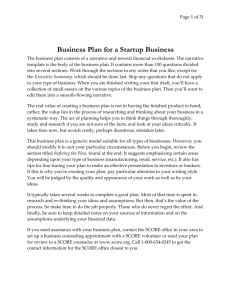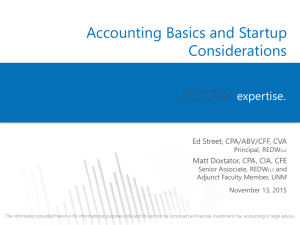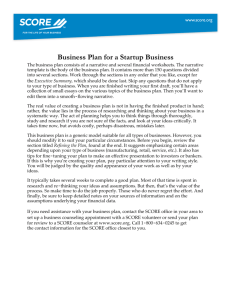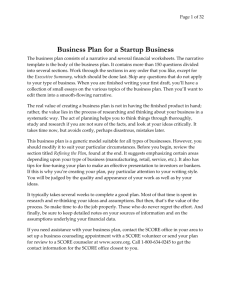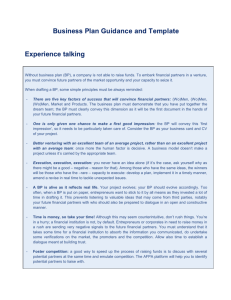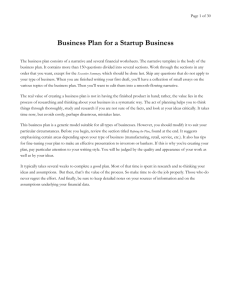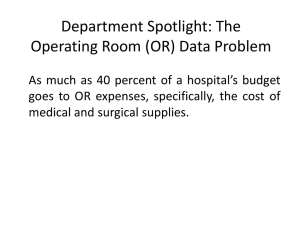Business Plan Guide
advertisement
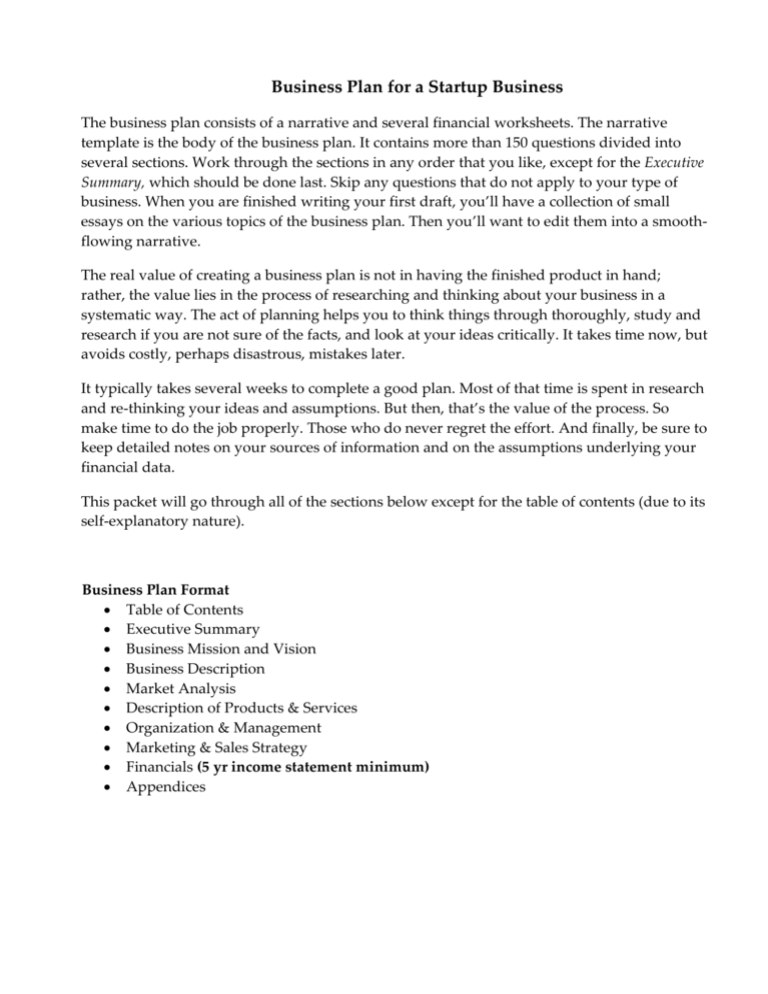
Business Plan for a Startup Business The business plan consists of a narrative and several financial worksheets. The narrative template is the body of the business plan. It contains more than 150 questions divided into several sections. Work through the sections in any order that you like, except for the Executive Summary, which should be done last. Skip any questions that do not apply to your type of business. When you are finished writing your first draft, you’ll have a collection of small essays on the various topics of the business plan. Then you’ll want to edit them into a smoothflowing narrative. The real value of creating a business plan is not in having the finished product in hand; rather, the value lies in the process of researching and thinking about your business in a systematic way. The act of planning helps you to think things through thoroughly, study and research if you are not sure of the facts, and look at your ideas critically. It takes time now, but avoids costly, perhaps disastrous, mistakes later. It typically takes several weeks to complete a good plan. Most of that time is spent in research and re-thinking your ideas and assumptions. But then, that’s the value of the process. So make time to do the job properly. Those who do never regret the effort. And finally, be sure to keep detailed notes on your sources of information and on the assumptions underlying your financial data. This packet will go through all of the sections below except for the table of contents (due to its self-explanatory nature). Business Plan Format Table of Contents Executive Summary Business Mission and Vision Business Description Market Analysis Description of Products & Services Organization & Management Marketing & Sales Strategy Financials (5 yr income statement minimum) Appendices I. Executive Summary Write this section last. Your executive summary should be two pages (or fewer). Include everything that you would cover in a five-minute interview. Fill in the following categories using the guidance questions below. The executive summary should be a condensed version of your full plan. That’s why it’s best to write the executive summary last. Explain the fundamentals of the proposed business: What will your product be? Who will your customers be? Who are the owners? What do you think the future holds for your business and your industry? Make it enthusiastic, professional, complete, concise, and visually appealing. Executive Summary Required Data Points: One Sentence Summary Overview of Business Problem Solved Product or Services Offered Market Overview Business Model Customers or Prospective Customer Sales & Marketing Strategy Competitive Environment Management Team Capital Needed Contact Info for Team Leader II. Business Mission and Vision What business will you be in? What will you do? Mission Statement: Many companies have a brief mission statement, usually in 30 words or fewer, explaining their reason for being and their guiding principles. If you want to draft a mission statement, this is a good place to put it in the plan, followed by: Company Goals and Objectives: Goals are destinations—where you want your business to be. Objectives are progress markers along the way to goal achievement. For example, a goal might be to have a healthy, successful company that is a leader in customer service and that has a loyal customer following. Objectives might be annual sales targets and some specific measures of customer satisfaction. Business Philosophy: What is important to you in business? III. Business Description This is the initial, somewhat detailed and specific introduction to what your business does. You will touch on several topics here which you will expand upon in later sections. Describe specifically your products or services (State it briefly here—you will do a more thorough explanation in the Description of Products & Services section) (Technical specifications, drawings, photos, sales brochures, and other bulky items don’t below in this section, they belong in Appendices). What factors will give you competitive advantages or disadvantages? Examples include level of quality or unique or proprietary features. What are the pricing, fee, or leasing structures of your products or services? To whom will you market your products? (State it briefly here—you will do a more thorough explanation in the Marketing & Sales Strategy section). Describe your most important company strengths and core competencies. What factors will make the company succeed? What do you think your major competitive strengths will be? What background experience, skills, and strengths do you personally bring to this new venture? Legal form of ownership: Sole proprietor, Partnership, Corporation, Limited liability corporation (LLC)? Why have you selected this form? Describe your industry. Is it a growing industry? What changes do you foresee in the industry, short term and long term? How will your company be poised to take advantage of them? IV. Market Analysis No matter how good your product and your service, the venture cannot succeed without effective marketing. And this begins with careful, systematic research. It is very dangerous to assume that you already know about your intended market. You need to do market research to make sure you’re on track. Use the business planning process as your opportunity to uncover data and to question your marketing efforts. Your time will be well spent. There are two kinds of market research: primary and secondary. Secondary research means using published information such as industry profiles, trade journals, newspapers, magazines, census data, and demographic profiles. This type of information is available in public libraries, industry associations, chambers of commerce, from vendors who sell to your industry, and from government agencies. Start with the Baylor library. Most librarians are pleased to guide you through their business data collection. You will be amazed at what is there. There are more online sources than you could possibly use. Your chamber of commerce has good information on the local area. Trade associations and trade publications often have excellent industry-specific data. Primary research means gathering your own data. For example, you could do your own traffic count at a proposed location, use the yellow pages to identify competitors, and do surveys or focus-group interviews to learn about consumer preferences. Professional market research can be very costly, but there are many books that show small business owners how to do effective research themselves. Facts about your industry: What is the total size of your market? What percent share of the market will you have? (This is important only if you think you will be a major factor in the market.) Current demand in target market. Trends in target market—growth trends, trends in consumer preferences, and trends in product development. Growth potential and opportunity for a business of your size. What barriers to entry do you face in entering this market with your new company? Some typical barriers are: o High capital costs o High production costs o High marketing costs o Consumer acceptance and brand recognition o Training and skills o Unique technology and patents o Unions o Shipping costs o Tariff barriers and quotas And of course, how will you overcome the barriers? How could the following affect your company? o Change in technology o Change in government regulations o Change in the economy o Change in your industry Customers Identify your targeted customers, their characteristics, and their geographic locations, otherwise known as their demographics. The description will be completely different depending on whether you plan to sell to other businesses or directly to consumers. If you sell a consumer product, but sell it through a channel of distributors, wholesalers, and retailers, you must carefully analyze both the end consumer and the middleman businesses to which you sell. You may have more than one customer group. Identify the most important groups. Then, for each customer group, construct what is called a demographic profile: Age Gender Location Income level Social class and occupation Education Other (specific to your industry) For business customers, the demographic factors might be: Industry (or portion of an industry) Location Size of firm Quality, technology, and price preferences Other (specific to your industry) Competition What products and companies will compete with you? Will they compete with you across the board, or just for certain products, certain customers, or in certain locations? Will you have important indirect competitors? (For example, video rental stores compete with theaters, although they are different types of businesses.) How will your products or services compare with the competition? Niche Now that you have systematically analyzed your industry, your product, your customers, and the competition, you should have a clear picture of where your company fits into the world. In one short paragraph, define your niche – your unique corner of the market. V. Description of Products & Services List all of your major products or services. For each product or service: Describe the most important features. What is special about it? Describe the benefits. That is, what will the product do for the customer? Note the difference between features and benefits, and think about them. For example, a house that gives shelter and lasts a long time is made with certain materials and to a certain design; those are its features. Its benefits include pride of ownership, financial security, providing for the family, and inclusion in a neighborhood. You build features into your product so that you can sell the benefits. What after-sale services will you give? Some examples are delivery, warranty, service contracts, support, follow-up, and refund policy. VI. Organization & Management Explain the daily operation of the business, its location, equipment, people, processes, and surrounding environment. Production How and where are your products or services produced? Explain your methods of: Production techniques and costs Quality control Customer service Inventory control Product development Location What qualities do you need in a location? Describe the type of location you’ll have. Physical requirements: Amount of space Type of building Zoning Power and other utilities Access: Is it important that your location be convenient to transportation or to suppliers? Do you need easy walk-in access? What are your requirements for parking and proximity to freeway, airports, railroads, and shipping centers? Include a drawing or layout of your proposed facility if it is important, as it might be for a manufacturer. Construction? Most new companies should not sink capital into construction, but if you are planning to build, costs and specifications will be a big part of your plan. Cost: Estimate your occupation expenses, including rent, but also including maintenance, utilities, insurance, and initial remodeling costs to make the space suit your needs. These numbers will become part of your financial plan. What will be your business hours? Legal Environment Describe the following: Licensing and bonding requirements Permits Health, workplace, or environmental regulations Special regulations covering your industry or profession Zoning or building code requirements Insurance coverage Trademarks, copyrights, or patents (pending, existing, or purchased) Personnel Who will manage the business on a day-to-day basis? What experience does that person bring to the business? What special or distinctive competencies? Is there a plan for continuation of the business if this person is lost or incapacitated? If you’ll have more than 10 employees, create an organizational chart showing the management hierarchy and who is responsible for key functions. Include position descriptions for key employees. If you are seeking loans or investors, include resumes of owners and key employees. Number of employees Type of labor (skilled, unskilled, and professional) Where and how will you find the right employees? Quality of existing staff Pay structure Training methods and requirements Who does which tasks? Do you have schedules and written procedures prepared? Have you drafted job descriptions for employees? If not, take time to write some. They really help internal communications with employees. For certain functions, will you use contract workers in addition to employees? Inventory What kind of inventory will you keep: raw materials, supplies, finished goods? Average value in stock (i.e., what is your inventory investment)? Rate of turnover and how this compares to the industry averages? Seasonal buildups? Lead-time for ordering? Suppliers Identify key suppliers: Names Type and amount of inventory furnished Credit and delivery policies History and reliability Should you have more than one supplier for critical items (as a backup)? Do you expect shortages or short-term delivery problems? Are supply costs steady or fluctuating? If fluctuating, how would you deal with changing costs? Professional and Advisory Support List the following: Board of directors Management advisory board Attorney Accountant Insurance agent Banker Consultant or consultants Mentors and key advisors VII. Marketing & Sales Strategy In your marketing plan, be as specific as possible; give statistics, numbers, and sources. The marketing plan will be the basis, later on, of the all-important sales projection. Promotion How will you get the word out to customers? Advertising: What media, why, and how often? Why this mix and not some other? Have you identified low-cost methods to get the most out of your promotional budget? Will you use methods other than paid advertising, such as trade shows, catalogs, dealer incentives, word of mouth (how will you stimulate it?), and network of friends or professionals? What image do you want to project? How do you want customers to see you? In addition to advertising, what plans do you have for graphic image support? This includes things like logo design, cards and letterhead, brochures, signage, and interior design (if customers come to your place of business). Should you have a system to identify repeat customers and then systematically contact them? Promotional Budget How much will you spend on the items listed above? Before startup? (These numbers will go into your startup budget.) Ongoing? (These numbers will go into your operating plan budget.) Pricing Explain your method or methods of setting prices. For most small businesses, having the lowest price is not a good policy. It robs you of needed profit margin; customers may not care as much about price as you think; and large competitors can under price you anyway. Usually you will do better to have average prices and compete on quality and service. Does your pricing strategy fit with what was revealed in your competitive analysis? Compare your prices with those of the competition. Are they higher, lower, the same? Why? How important is price as a competitive factor? Do your intended customers really make their purchase decisions mostly on price? What will be your customer service and credit policies? Proposed Location Probably you do not have a precise location picked out yet. This is the time to think about what you want and need in a location. Many startups run successfully from home for a while. You will describe your physical needs later, in the Operational Plan section. Here, analyze your location criteria as they will affect your customers. Is your location important to your customers? If yes, how? If customers come to your place of business: Is it convenient? Parking? Interior spaces? Not out of the way? Is it consistent with your image? Is it what customers want and expect? Where is the competition located? Is it better for you to be near them (like car dealers or fast food restaurants) or distant (like convenience food stores)? Distribution Channels How do you sell your products or services? Retail Direct (mail order, Web, catalog) Wholesale Your own sales force Agents Independent representatives Bid on contracts Sales Forecast Now that you have described your products, services, customers, markets, and marketing plans in detail, it’s time to attach some numbers to your plan. Use a sales forecast spreadsheet to prepare a month-by-month projection. The forecast should be based on your historical sales, the marketing strategies that you have just described, your market research, and industry data, if available. You may want to do two forecasts: 1) a "best guess", which is what you really expect, and 2) a "worst case" low estimate that you are confident you can reach no matter what happens. Remember to keep notes on your research and your assumptions as you build this sales forecast and all subsequent spreadsheets in the plan. This is critical if you are going to present it to funding sources. VIII. Financials (must have at least a detailed 5 year projected income statement) You will have many startup expenses before you even begin operating your business. It’s important to estimate these expenses accurately and then to plan where you will get sufficient capital. This is a research project, and the more thorough your research efforts, the less chance that you will leave out important expenses or underestimate them. Even with the best of research, however, opening a new business has a way of costing more than you anticipate. There are two ways to make allowances for surprise expenses. The first is to add a little “padding” to each item in the budget. The problem with that approach, however, is that it destroys the accuracy of your carefully wrought plan. The second approach is to add a separate line item, called contingencies, to account for the unforeseeable. This is the approach we recommend. Talk to others who have started similar businesses to get a good idea of how much to allow for contingencies. If you cannot get good information, we recommend a rule of thumb that contingencies should equal at least 20 percent of the total of all other start-up expenses. Explain your research and how you arrived at your forecasts of expenses. Give sources, amounts, and terms of proposed loans. Also explain in detail how much will be contributed by each investor and what percent ownership each will have. The financial plan consists of a 12-month profit and loss projection (also called an income statement), a five-year profit and loss projection, a cash-flow projection, a projected balance sheet, and a break-even calculation (optional). Together they constitute a reasonable estimate of your company's financial future. More important, the process of thinking through the financial plan will improve your insight into the inner financial workings of your company. Income Statement Many business owners think of the 12-month profit and loss projection as the centerpiece of their plan. This is where you put it all together in numbers and get an idea of what it will take to make a profit and be successful. Your sales projections will come from a sales forecast in which you forecast sales, cost of goods sold, expenses, and profit month-by-month for one year. Profit projections should be accompanied by a narrative explaining the major assumptions used to estimate company income and expenses. Research Notes: Keep careful notes on your research and assumptions, so that you can explain them later if necessary, and also so that you can go back to your sources when it’s time to revise your plan. Five-Year Profit Projection The 12-month projection is the heart of your financial plan, but the Five-Year Profit projection is for those who want to carry their forecasts beyond the first year. It must be included in your business plan for this competition. Of course, keep notes of your key assumptions, especially about things that you expect will change dramatically after the first year. Projected Cash Flow If the profit projection is the heart of your business plan, cash flow is the blood. Businesses fail because they cannot pay their bills. Every part of your business plan is important, but none of it means a thing if you run out of cash. The point of this worksheet is to plan how much cash you need before startup, for preliminary expenses, operating expenses, and reserves. You should keep updating it and using it afterward. It will enable you to foresee shortages in time to do something about them—perhaps cut expenses, or perhaps negotiate a loan. But foremost, you shouldn’t be taken by surprise. There is no great trick to preparing it: The cash-flow projection is just a forward look at your checking account. For each item, determine when you actually expect to receive cash (for sales) or when you will actually have to write a check (for expense items). You should track essential operating data, which is not necessarily part of cash flow but allows you to track items that have a heavy impact on cash flow, such as sales and inventory purchases. You should also track cash outlays prior to opening in a pre-startup column. You should have already researched those for your startup expenses plan. Your cash flow will show you whether your working capital is adequate. Clearly, if your projected cash balance ever goes negative, you will need more start-up capital. This plan will also predict just when and how much you will need to borrow. Explain your major assumptions, especially those that make the cash flow differ from the Profit and Loss Projection. For example, if you make a sale in month one, when do you actually collect the cash? When you buy inventory or materials, do you pay in advance, upon delivery, or much later? How will this affect cash flow? Are some expenses payable in advance? When? Are there irregular expenses, such as quarterly tax payments, maintenance and repairs, or seasonal inventory buildup, that should be budgeted? Loan payments, equipment purchases, and owner's draws usually do not show on profit and loss statements but definitely do take cash out. Be sure to include them. And of course, depreciation does not appear in the cash flow at all because you never write a check for it. Opening Day Balance Sheet A balance sheet is one of the fundamental financial reports that any business needs for reporting and financial management. A balance sheet shows what items of value are held by the company (assets), and what its debts are (liabilities). When liabilities are subtracted from assets, the remainder is owners’ equity. Use a startup expenses and capitalization spreadsheet as a guide to preparing a balance sheet as of opening day. Then detail how you calculated the account balances on your opening day balance sheet. Add a projected balance sheet showing the estimated financial position of the company at the end of the first year. This is especially useful when selling your proposal to investors. You need only do a projected balance sheet for the first year. Break-Even Analysis (optional) A break-even analysis predicts the sales volume, at a given price, required to recover total costs. In other words, it’s the sales level that is the dividing line between operating at a loss and operating at a profit. Expressed as a formula, break-even is: Break-Even Sales = Fixed Costs 1- Variable Costs (Where fixed costs are expressed in dollars, but variable costs are expressed as a percent of total sales.) Include all assumptions upon which your break-even calculation is based. IX. Appendices Include details and studies used in your business plan; for example: Brochures and advertising materials Industry studies Blueprints and plans Maps and photos of location Magazine or other articles Detailed lists of equipment owned or to be purchased Copies of leases and contracts Letters of support from future customers Any other materials needed to support the assumptions in this plan Market research studies List of assets available as collateral for a loan

